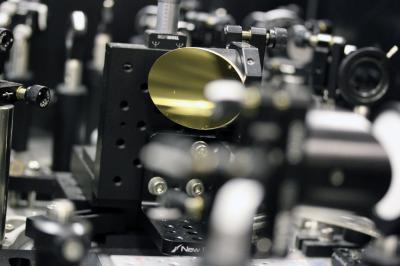Jan 20 2014
Scientists at the U.S. Department of Energy's Ames Laboratory have demonstrated broadband terahertz (THz) wave generation using metamaterials.
 A THz spectrometer driven by femtosecond laser pulses was used by Ames Laboratory scientists to demonstrate THz emission from a split-ring resonator metamaterial of single nanometer thickness. Credit: US Department of Energy's Ames Laboratory
A THz spectrometer driven by femtosecond laser pulses was used by Ames Laboratory scientists to demonstrate THz emission from a split-ring resonator metamaterial of single nanometer thickness. Credit: US Department of Energy's Ames Laboratory
The discovery may help develop noninvasive imaging and sensing, and make possible THz-speed information communication, processing and storage. The results appeared in the Jan. 8 issue of Nature Communications.
Terahertz electromagnetic waves occupy a middle ground between electronics waves, like microwave and radio waves, and photonics waves, such as infrared and UV waves. Potentially, THz waves may accelerate telecom technologies and break new ground in understanding the fundamental properties of photonics. Challenges related to efficiently generating and detecting THz waves has primarily limited their use.
Traditional methods seek to either compress oscillating waves from the electronic range or stretch waves from the optical range. But when compressing waves, the THz frequency becomes too high to be generated and detected by conventional electronic devices. So, this approach normally requires either a large-scale electron accelerator facility or highly electrically-biased photoconductive antennas that produce only a narrow range of waves.
To stretch optical waves, most techniques include mixing two laser frequencies inside an inorganic or organic crystal. However, the natural properties of these crystals result in low efficiency.
So, to address these challenges, the Ames Laboratory team looked outside natural materials for a possible solution. They used man-made materials called metamaterials, which exhibit optical and magnetic properties not found in nature.
Costas Soukoulis, an Ames Laboratory physicist and expert in designing metamaterials, along with collaborators at Karlsruhe Institute of Technology in Germany, created a metamaterial made up of a special type of meta-atom called split-ring resonators. Split-ring resonators, because of their u-shaped design, display a strong magnetic response to any desired frequency waves in the THz to infrared spectrum.
Ames Laboratory physicist Jigang Wang, who specializes in ultra-fast laser spectroscopy, designed the femto-second laser experiment to demonstrate THz emission from the metamaterial of a single nanometer thickness.
"The combination of ultra-short laser pulses with the unique and unusual properties of the metamaterial generates efficient and broadband THz waves from emitters of significantly reduced thickness," says Wang, who is also an associate professor of Physics and Astronomy at Iowa State University.
The team demonstrated their technique using the wavelength used by telecommunications (1.5 microns), but Wang says that the THz generation can be tailored simply by tuning the size of the meta-atoms in the metamaterial.
"In principle, we can expand this technique to cover the entire THz range," said Soukoulis, who is also a Distinguished Professor of physics and astronomy at Iowa State University.
What's more, the team's metamaterial THz emitter measured only 40 nanometers and performed as well as traditional emitters that are thousands of times thicker.
"Our approach provides a potential solution to bridge the 'THz technology gap' by solving the four key challenges in the THz emitter technology: efficiency; broadband spectrum; compact size; and tunability," said Wang.